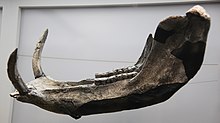Metridiochoerus is an extinct genus of swine known from the Pliocene and Pleistocene of Africa. It is also known as the giant warthog.
| Metridiochoerus Temporal range: Late Pliocene to Late Pleistocene
| |
|---|---|

| |
| Jaw of M. hopwoodi at National Museum of Natural History | |

| |
| M. andrewsi (centre) compared to a living Desert warthog (left) and Notochoerus eulius (right) | |
| Scientific classification | |
| Domain: | Eukaryota |
| Kingdom: | Animalia |
| Phylum: | Chordata |
| Class: | Mammalia |
| Order: | Artiodactyla |
| Family: | Suidae |
| Subfamily: | Suinae |
| Genus: | †Metridiochoerus Hopwood, 1926 |
| Type species | |
| †Metridiochoerus andrewsi Hopwood, 1926
| |
| Species | |
| |
Chronology edit
The oldest specimen dates to around 3.4 million years ago from the Usno Formation in Ethiopia.[1] It probably evolved from a recent immigrant from Eurasia, which has been suggested to be the European "Postpotamochoerus" provincialis.[2] The youngest remains of the genus date to the Late Pleistocene in southern Africa (Zimababwe, and possibly South Africa).[3]
Description edit
Metridiochoerus was a large animal, 1.5 metres (4.9 ft) in length, resembling a giant warthog. It had two large pairs of tusks which were pointed sideways and curved upwards.[4] The teeth, especially the third molars, become increasingly high crowned (hypsodont) in later species.[1]
Biology edit
The various species are usually thought to have been grazers,[3] though this has been questioned for the earliest low crowned species.[1]
References edit
- ^ a b c White, Tim D.; Howell, F. Clark; Gilbert, Henry (January 2006). "The earliest Metridiochoerus (Artiodactyla: Suidae) from the Usno Formation, Ethiopia". Transactions of the Royal Society of South Africa. 61 (2): 75–79. doi:10.1080/00359190609519955. ISSN 0035-919X.
- ^ M. Pickford ‘Locomotion, diet, body weight, origin and geochronology of Metridiochoerus andrewsi from the Gondolin Karst Deposits, Hauteng, South Africa’ Ann. Ditsong Natl. Mus. Nat. Hist., 3 (1) (2013), pp. 33-47
- ^ a b Faith, J. Tyler (January 2014). "Late Pleistocene and Holocene mammal extinctions on continental Africa". Earth-Science Reviews. 128: 105–121. doi:10.1016/j.earscirev.2013.10.009.
- ^ Palmer, D., ed. (1999). The Marshall Illustrated Encyclopedia of Dinosaurs and Prehistoric Animals. London: Marshall Editions. p. 269. ISBN 1-84028-152-9.
- Barry Cox, Colin Harrison, R.J.G. Savage, and Brian Gardiner. (1999): The Simon & Schuster Encyclopedia of Dinosaurs and Prehistoric Creatures: A Visual Who's Who of Prehistoric Life. Simon & Schuster.
- David Norman . (2001): The Big Book Of Dinosaurs. pg. 226, Walcome books.
- World Encyclopedia of Dinosaurs & Prehistoric Creatures: The Ultimate Visual Reference To 1000 Dinosaurs And Prehistoric Creatures Of Land, Air And Sea ... And Cretaceous Eras (World Encyclopedia) by Dougal Dixon